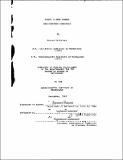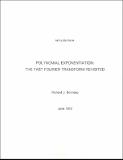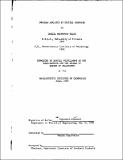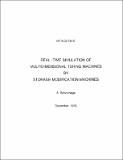Browsing Project MAC by Title
Now showing items 123-142 of 176
-
Petri Net Language
(1976-03)In a labeled Petri Net we assign symbols from an alphabet to some or all the transitions of a Petri Net. To each firing sequence of such a Labeled Petri Net corresponds to a string over the alphabet. We study the languages ... -
Pilot: A Step Towards Man-Computer Symbiosis
(1966-09)PILOT is a programming system constructed in LISP. It is designed to facilitate the development of programs by easing the familiar sequence: write some code, run the program, make some changes, write some more code, run ... -
A Portable Compiler for the Language C
(1975-05)This paper describes the implementation of a compiler for the language C. The compiler has been designed to be able to be capable of producing assembly-language code for most register-oriented machines with only minor recoding. -
Practical Translators for LR(k) Languages
(1969-10)A context-free syntactical translator (CFST) is a machine which defines a translation from one context-free language to another. A transduction grammar is a formal system based on a context-free grammar and it specifies ... -
A Preliminary Study in Computer-aided Legal Analysis
(1975-11)This paper describes the prototype for a computer system that can perform a simple kind of legal analysis. The system user, who is presumed to be a lawyer, describes to the system a hypothetical set of facts. The system ... -
Primary Access Control in Large-scale Time-shared Decision Systems
(1971-07)The computer differs from other tools in that it presently does not provide its users with a working environment transparent to their desires; in particular, current computer systems do not support adequate mechanisms for ... -
The Priority Problem
(1965-11)Priority decisions arise whenever limited facilities must be apportioned among competitive demands for service. Broadly viewed, even the familiar first-come-first served discipline is a priority rule. It favors the ... -
Productivity in Parallel Computational Schemata
(1973-12)A general model for parallel computation is developed in three parts. One part, the data flow graph, describes how actors which transform and test values are connected to the locations in a finite memory. Another part, ... -
Program Analysis by Digital Computer
(1967-08)A comparison of the properties of non-modifying and self-modifying programs leads to the definition of independent and dependent instructions. Because non-modifying programs contain only independent instructions, such ... -
Program Restructuring for Virtual Memory Systems
(1975-03)The problem area addressed in this report is program restructuring, a method of reordering the relocatable sectors of a program in its address space to increase the locality of the programs reference behavior, thereby ... -
Program Structure in a Multi-access Computer
(1964-05)A multi-access computer (MAC) system consists of processing units and directly addressable main memory in which procedure information is interpreted as sequences of operations on data, a system of terminal devices ... -
Programming Semantics for Multiprogrammed Computations
(1965-12)The semantics are defined for a number of meta-instructions which perform operations essential to the writing of programs in multiprogrammed computer systems. These meta-instructions relate to parallel procession, protection ... -
Pseudo-random Sequences
(1970-10)The purpose of this paper is to study some notions of randomnes for infinite sequences of 0's and 1's. -
Queueing Models for File Memory Operation
(1965-10)A model for the auxiliary memory function of a segmented, multiprocessor, time-shared computer system is set up. A drum system in particular is discussed, although no loss of generality is implied by limiting the discussion ... -
Real-time Simulation of Multidimensional Turing Machines by Storage Modification Machines
(1973-12)In [1] the author introduced a new machine model, now called the Storage Modification Machine (SMM). It was claimed, but not proved, that SMM's can simulate all sorts of Turing machines-- those with multidimensional worktapes ... -
Recognition of Translators Invariants* By Iterative Arrays
(1969-10)A study is made of the recognition and transformation of figures by iterative arrays of finite state automata. A figure is a finite rectangular two-dimensional array of symbols. The iterative arrays considered are also ... -
The Reduction Method for Establishing Lower Bounds on the Number of Additions
(1974-06)A method for establishing lower bounds on the number of multiplications and divisions has been developed by Pan, Winograd and Strassen. A similar method is developed for establishing lower bounds on the number of additions ... -
The Relational Approach to the Management of Data Bases
(1971-04)The ultimate goal of Project MacAIMS (MAC Advanced Interactive Management System) is to build a computer facility which will be able to support non-trivial decision making processes. (See reference 4). In the early stages ... -
Relativization of the Theory of Computational Complexity
(1972-06)Blum's machine-independent treatment of the complexity of partial recursive functions is extended to relative algorithms (as represented by Turing machines with oracles). We prove relativizations of several results of ...




















